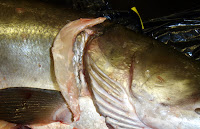


After making a failed run to find suckers this morning (didn't stop to check store hours... apparently the place is closed on Mondays!), Hedrik and I decided a little fishing
somewhere was just what the doctor ordered. The question was, where? We could not find a trolling motor to drift a section of river near downtown Ottawa, so we hooked up the boat and trailered it a block away from Little Italy!
Though the pasta with bolognese and vintage pinot grigio tempted us, the thought of seeing a hungry muskie chase down a lure was even more appetizing! We launched at Dow's Lake which is a 10 minute walk from Carleton University, and the site of many classes that Dr. Cooke teaches.
I started off the outing with a follow from a fish of unknown size on a bucktail. A little while later, Hedrik had another follow on a Bulldawg from a low-30s fish. We proceeded to fish the base of a restaurant where I got a follow from a knee-knocker of a fish (upper 40 inches, pushing 50). After that follow, things slowed for us. So, we returned to the location we began our day at.
I clipped on the same lure that got our first follow and cast it in nearly the same location as said follow, and WHAMMY (that's for all you "Anchorman" fans out there...)! Fish on! As the muskie came in towards the boat, I thought I caught a glimpse of a Floy tag. I didn't say anything because I didn't really believe my eyes, but once the fish was in the net I confirmed my first glimpse. There before us sat a previously tagged muskie! This was a fish from a study by Dr. Cooke and his students on the movements of muskellunge in Dow's Lake. The fish in the study were implanted with internal radio transmitters (as opposed to the external radio transmitters we are using), and hanging from the belly of this fish was a wire antenna protruding from a small incision! DE-
CENT (for all you "Trailer Park Boys"/Bubbles fans...)! The fish taped out at 40 inches, and I am in the process of trying to get data on when it was first captured.
Unfortunately, the ramp at Dow's Lake closes at 5PM so Hedrik and I had to leave despite getting two more HOT follows from 42-43 inch fish. I was having an internal battle with myself about whether to go home and walk to Dow's, when Hedrik suggested we move to another stretch of river downstream from Dow's Lake. Obviously, this was a good idea so we trailered the boat again and moved down to Mooney's Bay on the other side of Carleton's campus.
We didn't have much time to fish, so Hedrik took me to one of his best producing spots. I clipped on a Tuff Shad (crankbait) and hoped it would finally catch me a fish (never has). I wasn't let down as at the deepest portion of the bait's dive curve it came to a complete stop! I hammered the hooks home and could feel hard, gut wrenching headshakes. The fish then proceeded to zip around the boat like a torpedo from the USS Viriginia, roll, zip around some more, roll, take another drag peeling run, dive beneath the boat, and roll some more. After all these wild antics, the fish finally rolled so much in the line that it basically entangled itself and I was easily able to guide it into the net. I can honestly say this was the friskiest fish I've ever caught! It wouldn't even hold still in the trough (a rarity)! This fish taped out at just over 40 inches.
All in all, it was a good day! Now if we can figure out where to get those darn suckers... :)
[That's the Dunton Tower (houses a variety of different institutes, schools, and departments) at Carleton in the background of the first picture, and what look to be office buildings in downtown Ottawa in the third picture.]



















